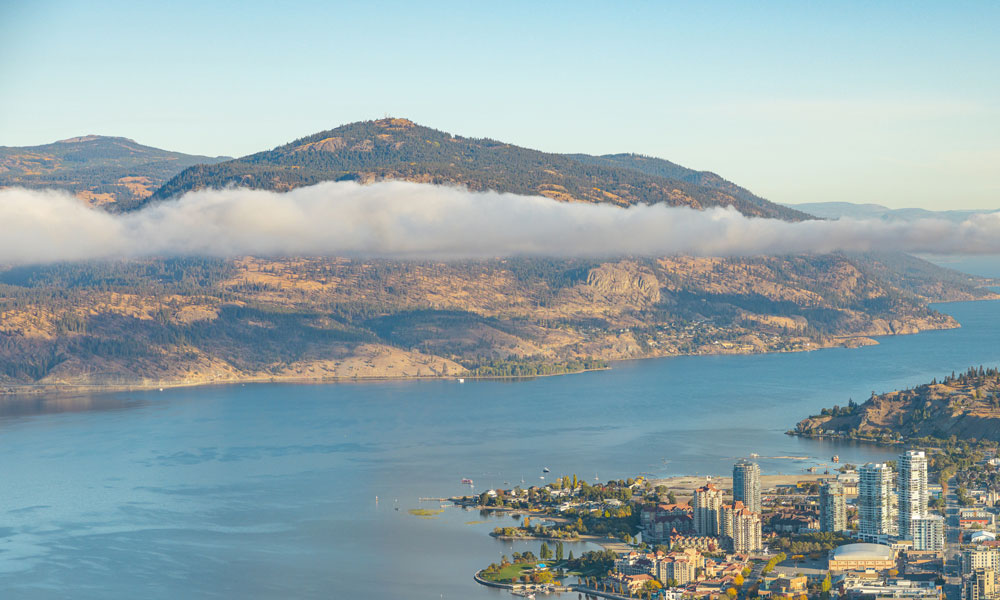
“siwɬkʷ (WATER) IS SACRED AND IS LIFE FOR ALL PEOPLE. We know from our histories and our knowledge that water is one of the most important resources available to humans and animals.”
But for Dawn Machin and Sarah Alexis, both from snƛ̓x̌ʷx̌ʷtan (Six-Mile Creek area in the North Arm of Okanagan Lake), there’s a disconnect between what water represents to humanity and how it’s perceived.
“People seem to think more about managing water as a commodity, or as something we need to be protected from, regardless of the fact they’ve built their homes in flood plains along creeks and lakes that now overflow,” explains Machin. “Things like dams, channelization and habitat destruction of fish and wildlife aren’t thought about.”
Nor do people consider the vast amounts of water exported globally through products like fruit and wine—two vital and booming industries in the Okanagan Valley. According to the Okanagan Basin Water Board, the Okanagan has one of the highest rates of water use per person in Canada, with agriculture in the region using a staggering 55 per cent of all water.
“It bothers me emotionally about the use of water in the Okanagan,” Machin says. “Ultimately, water connects to so many things; to people, to animals and plants. I don’t think people realize this.”
Machin and Alexis are both exploring the varied—and often complex—relationships water can have in the Okanagan Valley. Important to their master’s research is using Syilx Indigenous knowledge to not only inform, but guide their work.
“Our captikʷł—our stories and oral history—have been handed down from generation to generation, and that’s our science. Because of this, we have a deep understanding of what’s happening to our land and the water,” Alexis says.
Through her Master of Science in Biology, Machin is researching the restoration of Okanagan chinook and cottonwood populations in the Okanagan Lake system. History and knowledge from the Syilx People of the Okanagan Nation are helping to determine spawning patterns for specific salmon, since oral histories initially documented where these salmon travelled and reproduced. This information is crucial to understanding which creeks fish historically used, and the flow conditions they experienced before dams were built throughout the Okanagan Valley in the 1930s.

Although Okanagan Lake is the sixth deepest in BC and the 15th deepest in Canada, Kelowna and surrounding cities still experience periods of drought. This is because the lake is found in the arid Okanagan Valley basin, which sees only 15 per cent of falling snow and rain flow to lakes and remain there.
In a related project, Machin is part of UBC Okanagan’s Cluster of Research Excellence in Watershed Ecosystems, working to assess critical linkages and interactions in the sqʷʔa (Peachland Creek) watershed. Through this project, Machin is conducting research with Dr. Jeannette Armstrong to determine if and how Syilx communities will engage in research related to stressors on Indigenous Okanagan Syilx values, and the incorporation of Syilx values in governance.
Elsewhere, in the Irving K. Barber Faculty of Arts and Social Sciences, Alexis is focusing her Interdisciplinary Graduate Studies program on the WaterWays project. A multi-year Social Sciences and Humanities Research Council-funded initiative, the project is exploring two distinct avenues: the return of salmon after dams were built in the Okanagan Valley, and the creation of an eco-community centre at the En’owkin Centre.
“The premise of both these multi-year projects is looking at what makes them so successful in terms of collaboration and partnership, and in terms of Syilx leadership in these restoration projects,” Alexis explains. “We’re also looking at how Syilx values, beliefs and practices are at the centre of these projects.”
Accompanying the project is an immersive audio and visual exhibition showcasing the vibrancy of the Okanagan throughout the seasons, along with hours of interviews about Syilx governance, leadership, restoration, Indigenous world view and nsyilxcn.
“The visualization captures the beauty of this place, but there’s also this idea present that this perfect world we think we live in isn’t quite so perfect,” Alexis says. “This project enables people to understand how Syilx people see and understand their relationship to water.”
“We’re doing this for future generations, not just for Syilx people….I don’t know if people understand that or think that far ahead. What will happen in a hundred years? What will this valley look like, and will Okanagan Lake even still be there?”
Alexis points to the captikʷł about older sibling and little sibling when discussing solutions from her research, and how society can hopefully change its attitude towards water.
“In our stories, little sibling is often portrayed as settlers or newcomers who are not Syilx, and the premise is that older sibling has to take care of little sibling. It’s this idea of kinship, because you don’t leave your family even if they act like they know everything.
“The idea of my research is to create a story that can help little sibling understand the importance of water, and help get a better idea of how they can Indigenize, Syilx-ify to this place. I strongly believe that when Syilx values are common across the board, then we won’t have to face so many struggles when it comes to restoration work.”
Machin agrees. “We’re doing this for future generations, not just for Syilx people,” she explains. “The work we’re doing to restore fisheries and protect the water and land, it’s for the benefit of all those people to come. I don’t know if people understand that or think that far ahead. What will happen in a hundred years? What will this valley look like, and will Okanagan Lake even still be there?”
“Our research is a stepping stone for future generations, because their work will be just as hard.”